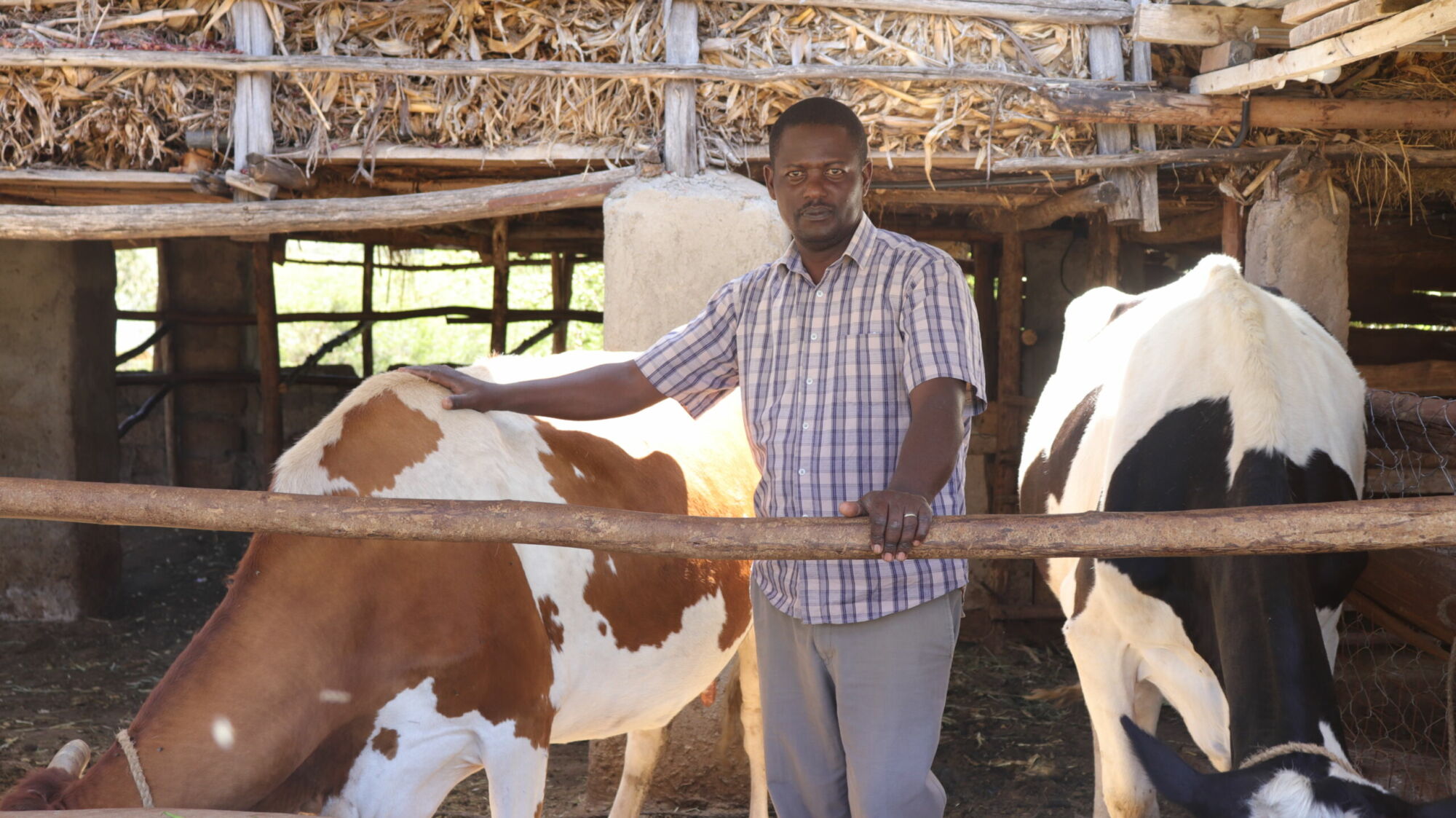Mr Jacob Wambua is an example of a successful peri-urban dairy farmer in Kenya. He produces 75 litres of milk per day from 11 cows on his 10 -acre piece of land. Despite the dry weather conditions limiting his access to animal feed, he runs a successful dairy enterprise that supplies milk to a local dairy cooperative known as Masaku.
Kitanga, Mua Hills, Machakos is a semi-arid area. Farmers in this area experience drought due to the adverse effects of climate change. To mitigate the effects of harsh climatic conditions, microinsurance products have been helpful in supporting dairy farming.
The story of Jacob Wambua demonstrates how a dairy farmer in a dry area is still able to increase milk production.
Over a decade ago, Jacob Wambua ventured into dairy farming with only one cow after acquiring a loan of Ksh 30,000/=(SEK 2,300) from a Savings and Credit Co-operative (SACCO) where he was a member.
Years later, he left formal employment, grew his herd and fully concentrated on dairy farming on his 10-acre piece of land located at Kitanga, Mua Hills Village in Machakos County, Kenya.
“Over the years, my herd has grown exponentially, and I currently have eleven Friesian dairy cows—the cost of my mature cows’ ranges from Ksh 100,000 – 180,000/= (SEK 7,989 to 14,381) ’’, explains Wambua. “My lactating cows produce 70 -75 litres of milk per day. I take 50 litres to the dairy co-operative where the cost of milk ranges from Ksh 40 – 60/=, (SEK 3 to 4) and sell 20 litres at my milk shop’’. Consequently, he has joined Masaku Cooperative society to gain more knowledge on the dairy enterprise, access collective markets for better prices and a guaranteed market and add value through bulk processing.
As a result of the increase in milk production, his income has also increased, which has helped him meet the family’s needs more effectively.
“Dairy farming is my passion, and it has been a rewarding venture’’, he said.
To crown his efforts, in 2016, Wambua participated in the Machakos Agricultural Society of Kenya (ASK) show and emerged second runners up and in 2018, he emerged the overall winner.
Dairy Enterprise is a considerable investment with very high risks. The milk from the cows is an invaluable source of income, and the loss of an animal can have adverse consequences on the farmers and their families.
In partnership with Lower Eastern Dairy Cooperative Alliance (LEDCA)- an apex body for dairy co-operatives, We Effect, has trained farmers on microinsurance and how their products can shield them from the risk associated with a dairy enterprise. The training helps them manage risks and take up affordable insurance products.
Lower Eastern Dairy Cooperative Alliance (LEDCA) currently comprises 3,746 farmers, of whom 1,716 are women, and 2,030 are men distributed in twenty-seven Dairy Cooperative societies spread across Machakos and Makueni Counties.
“In the past, I lost three cows due to death from diseases,” explains Wambua.
Fortunately, he had taken up insurance with Cooperative Insurance Company (CIC). Currently, he is paying an advance of Ksh 35,000/= (SEK 2796) for the annual insurance premium for his 11 cows.
“For the first loss, the initial cost of my heifer was Ksh 70,000 /= (SEK. 5592), and the sum paid by the insurance company after the loss was Ksh 60,000/= (SEK 4793)”, Wambua remembers. For the second case, he was paid 90% of his cow’s total value, a price that was determined by a veterinarian. The sum value was Ksh 100,000/= (SEK 7989) and was paid Ksh 90,000/= (SEK 7190).
90% of Kenya’s milk production comes from small-scale dairy farmers. We Effect through the Sustainable Rural Development Programme (SRD) is implementing the Promoting Equality in Dairy Enterprise (PEDE) project whose objective is to reach out to 2617 smallholder dairy farmers directly and 11,515 indirectly comprising of 60% women and 40% men living in the Lower Eastern counties.
Through LEDCA, farmers have received training on insurance and affordable insurance products and have also linked farmers with banks such as co-operative bank and CIC as the insurance agent.
Insurance has given Wambua peace of mind. It has removed unnecessary fear and anxiety in his investment, currently valued at Ksh 900,000/= (SEK 71904). He can now give his best to the dairy enterprise. He provides tender care and love to his cows, assured of a refund in case of any unforeseen happenings.
Microinsurance has helped him increase his herd, translating to increased milk production. This has enabled him to educate his children and provide balanced nutrition to his family. The manure from his farm also comes in handy for his orchard farm, where he plants various fruits, such as bananas, avocados, mangoes, and oranges.
“I encourage farmers to look at farming as a business. Let’s reduce our risks and take up insurance,” urges Wambua. He further confidently says that; “the future is bright for dairy farmers in the region. “My farm is now seen as a benchmark, and the increased income has enabled me to pay school fees for my children comfortably.”
Low-income earners remain more vulnerable to the effects and risks related to climate change. These risks include loss of agricultural yield due to droughts, floods, high medical costs, injury, or loss of life as sole breadwinners.
While most of these risks are insurable, the challenge remains accessibility, affordability, and availability of the right products.
To enable low-income earners to access micro insurance, We Effect has partnered with financial service providers and insurance companies in East Africa to sensitize communities on the importance of insurance, develop affordable insurance, and establish effective distribution channels among partner organizations.
